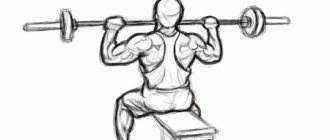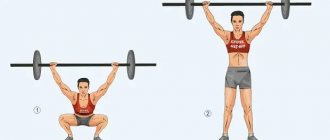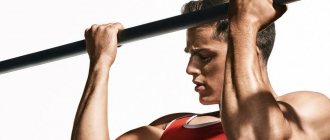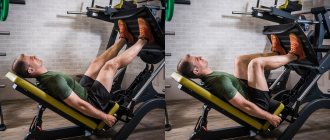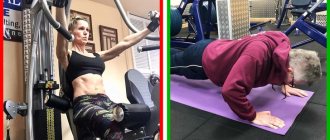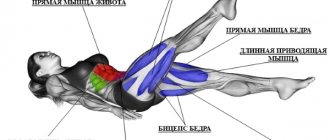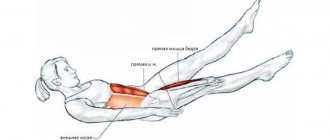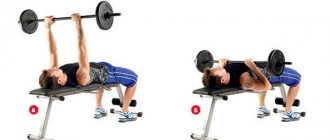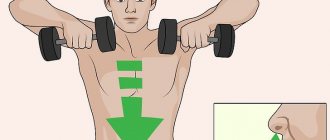August 12, 2015 Admin Home page » Average delta
The correct technique for pressing a barbell from behind the head, the starting position, other exercises for the middle delta, important tips and main rules + a visual training video are described.
A classic basic exercise for pumping up the middle fascicle of the deltoid muscle; the anterior fascicle, trapezius, triceps, serratus anterior and stabilizer muscles receive less load.
The benefits and harms of overhead presses
This exercise has one advantage - a high load on the middle part of the deltoids. However, there are many different exercises that are much safer than this option.
The overhead bench press has many more disadvantages:
- Firstly, due to the unnatural position of the shoulder joints, the joint capsule can be injured.
- Secondly, as in other vertical presses, there is a load on the spinal column.
- There is also a high risk of spraining the ligaments.
- Another disadvantage is working with light weight. Of course, it is possible to place as many weighting discs as you like, however, in this case, injury is guaranteed!
- The exercise is strictly not recommended for people who have injuries such as hernia or protrusion of intervertebral discs, and the exercise is also contraindicated for those who have osteochondrosis.
Vital recommendations
The following rules will help you avoid very unpleasant injuries:
- Raise the barbell as you exhale, lower it as you inhale. A slow pace and smooth movements are the best load on the muscles. No jerking - you can stretch your deltoids.
- Keep your lower back arched, your back straight, looking only forward (no lowering your gaze or looking at mosquitoes on the ceiling).
- The right weight is one that you can lift the required number of times with the right technique, but no more. If you can do a few more reps, the weight is light.
- If you have lumbar osteochondrosis, hernia or protrusion, use an orthopedic belt every time you stand or sit under working weight. This is the prevention of complications and exacerbations of back diseases.
- Performing the exercise while pressing against the vertical back of the bench is easier, in fact, as in Smith. Your body does not have to strain to maintain balance. Therefore, this is the best option for beginners. Smith also allows you to secure the exercise - you can do it without insurance.
- If the weight of an empty bar (usually 20 kg for a free bar, and 20-25 for a Smith machine) is too heavy for warming up, use dumbbells or lighter bars (ask your trainer if there are any at the gym). It’s better not to approach working weights without warming up!
What muscles work in the overhead press?
The overhead barbell press is aimed at developing the middle bundles of the deltoid muscles. But the work also involves the posterior deltoids, trapezius muscles and triceps.
Description of the exercise and its types
This exercise has 2 variations: sitting and standing . Each athlete chooses a more suitable position for himself depending on his goals. In addition, some believe that the seated barbell press is more detrimental to the normal functioning of the spine. Others claim that seated presses are more effective for developing shoulder muscles.
Experienced athletes claim that training in a sitting position leads to severe stress on the spine. And this is harmful for the vertebrae, which can move minimally, but at the same time cause maximum health discomfort. But on the other hand, when bench pressing while sitting, more muscles are involved in the work, which brings a more effective result.
Most often, it is the deltoid muscles that are injured when performing this exercise. Therefore, if you have previously injured your deltoids under any circumstances, consult your doctor before starting training.
In a standing position, the risk of injury to your health is sharply reduced. There is always the opportunity to drop the barbell from your shoulders to the floor. But what type of press to use in a particular specific case is up to you. A certain mass of athletes do not have specific preferences; everyone trains according to the system that they have developed over the years, and which they consider more effective and safe.
Seated overhead press technique
This option is much safer than the standing press, provided that the bench has a back on which you must lean your elbows. The sitting overhead bench press is suitable for those athletes who have problems with the spine. This exercise is best done with support. Alone, the overhead press can only be done in a Smith machine, but more on that later.
- First you need to set the angle of the back of the bench. It is 90 degrees.
- After sitting on the bench, the athlete must remove the barbell from its mountings. The placement of the hands on the bar is average (slightly wider than shoulder width). Elbows should form a right angle. Don't forget about arching your lower back.
- The first approach is not even a warm-up, but a trial one, best done with an empty bar. Please note that you need to increase the weight of the sports equipment little by little.
- Movements are performed smoothly, without jerking. At the top point of the amplitude, there is no need to fully extend your elbows.
- The lowest point of amplitude is located at the level of the back of the head. If you lower the bar as low as possible, the trapezius muscles will be more involved.
- Inhalation is done while lowering the bar, and lifting is done while exhaling.
Deltoids
The deltoids wrap around the shoulder joint like a shoulder pad. They consist of 3 large bundles: anterior, posterior and middle. With a small thickness of the fat layer, you can see them when you move your arm to the side, back and forward. The middle (target in this exercise) beam forms a rounded shape of the shoulders, visually increasing their width.
The deltoids are a very vulnerable muscle; they get injured most often. Therefore, pay attention to the recommendations given in this article regarding this exercise!
Standing overhead press technique
This version of the overhead barbell press is suitable for experienced athletes who do not have problems with the spine.
There are two options for positioning your feet.
- The first is when the feet are shoulder-width apart;
- and the second, when one leg is in front and the other slightly behind for better stability.
The remaining recommendations and technical aspects are identical to the seated overhead press.
Execution options
This movement exists in three versions:
- Sitting with back support for those who have back problems and are unable to stand;
- Sitting without support, for those who do not need support, but want to remove excess stress on the spinal stabilizer muscles;
- Standing is the most commonly used option in professional sports.
In weightlifting, you are taught to press overhead while standing, because in this position the center of the body is collected, and the shoulders move in a plane that can be adjusted to suit the anatomy of a particular person.
Bodybuilders massively bench press while sitting, and even in a Smith machine, that is, with their back and elbows fixed. This type of bench press requires greater joint flexibility and greater amplitude. It turns out that an athlete should be gradually introduced to this bench press if he has problems with his joints.
The tests are quite simple. You need to stand facing the wall, press your chest against it, and stretch your arms up, and then bring them back. This movement should be possible without changing the angle of your forearms and without touching your palms to the wall. If a person “leans” his forearms forward and constantly changes the angle of work, he should work on the mobility of the shoulder joint and stretching the chest muscles. Typically, the warm-up includes arm circles, shoulder rolls, and variations of shrugs without weight. At the end of the workout, pull both arms back and stretch the chest. Over time, when the movement against the wall begins to work out, you can move on to overhead presses while standing and sitting.
In Smith, sitting on a sports bench
For beginners, many recommend working in the Smith machine, considering it safer. This is only true for those whose joints are mobile. The technique in the simulator is as follows:
- Position the bench so that the seat is under the bar of the machine;
- Place the backrest perpendicular to provide support and, if necessary, raise the seat of the bench;
- Grasp the bar with your hands slightly wider than your shoulders so that your forearm is perpendicular to the floor;
- Turn the Smith bar with your hands and lower it behind the head, to the middle of the head or slightly lower;
- Press up without changing the angle of the forearm;
- Lower down and do the required number of repetitions
Bodybuilders perform this movement so that the shoulder is level with a plane parallel to the floor. Going lower is not recommended to avoid injury. In weightlifting, the movement begins from the top of the trapezius, that is, the athlete places the barbell on the top of the trapezius and presses each time with straight arms.
Bench press
Seated free barbell press
A free barbell offers a number of benefits to the experienced athlete. He can work in the plane that allows him to better load the muscles, and does not make unnecessary movements of the elbows, shoulders and other parts of the body. You can also choose a comfortable grip, and you are not limited by the length of the bar in the Smith machine; for broad-shouldered people this can be a problem.
The lowering of the bar occurs smoothly, and most insist that their students stop in the middle of the amplitude and press the bar upward without bringing the bar to the trapezoid.
Standing press
Performing this bench press while standing is even more difficult. You will need to approach the barbell so that you can lift it with your hands behind your head for the starting position, and then move away from the racks with the barbell placed on your palms behind your head.
The technique of the exercise is as follows:
- The athlete stabilizes the body by moving away from the racks;
- Performs the required number of presses and lowers the barbell onto bent arms, and then approaches the racks and places the bar on them.
It's the BEHIND THE HEAD PRESS, baby!
Smith Overhead Press Technique
This option is best for those new to the gym and those whose fitness level is not yet good enough for overhead presses with free weights. This exercise has many advantages over other options.
- The Smith machine allows you to increase the working weight and perform the exercise without the support of a partner.
- The weight can be fixed at any point in the amplitude.
- Also, thanks to a more isolated press due to the movement of the bar strictly along the guides, the beginner will better work the target muscles.
The technique of performing an overhead press in a Smith machine is identical to the option while sitting on a bench.
Deltoids and the reason for their vulnerability
The deltoid muscle of the shoulder is made up of three muscle bundles:
- Frontal or anterior delta;
- Lateral or posterior;
- Medial or middle
The front deltoid helps with all pressing movements and lifts the arm forward. The back one takes you back, and the middle one brings the forearm perpendicular to the axis of the spine and helps lift the weight above the head. The overhead press puts more stress on the middle deltoid.
Important: Shoulder injuries and shoulder muscle strains are caused by overuse. Beginners rock their shoulders too much to achieve an aesthetic look faster, but end up getting injured more often than they benefit. The problem is that the deltoids cannot be developed well enough until overall muscle mass has been gained and the neuromuscular connections that facilitate proper technique have been established. You need to follow the rules for creating training programs and not overload your shoulders.
What and how to do?
After assessing all the risks, you can proceed directly to the technology. To perform the exercise you will need racks and a barbell with a load. We will perform the bench press while standing.
The sequence of actions is as follows:
- place the barbell on vertical racks and load it with the required weight. Then sit under the bar and move it slightly below the neck area. Now lift the barbell and move a little away from the racks (1-2 meters). Then take a stable position and straighten your back. This position is the starting position;
- lifting the projectile should be performed exclusively while exhaling. Therefore, take a full breath of air, gradually release it and lift the load. At the top point, stop and wait 1-2 seconds. After this, begin to smoothly lower the projectile behind your head, while inhaling;
- repeat the exercise as many times as necessary.
Features and nuances
To get the maximum benefit from the bench press and not harm yourself, you should listen to the recommendations of experienced athletes:
- the back must remain straight throughout the entire amplitude;
- the chest should be “pushed forward”;
- The elbow joints cannot be brought forward, they must remain in the projection of the bar;
- the lower position of the projectile is at the level of the eye line;
- it is important to stretch the deltoid muscles, paying attention to the rotator cuff muscles;
- you need to work at a certain pace, excluding jerks and accelerations;
- when lowering the projectile, a right angle should be maintained in the forearms;
- do not lower your head, it is better to look ahead;
- It is recommended to start with small weights;
- bench press heavy weights more safely from a seated position, using a bench with a backrest and not neglecting the belay of a partner;
- It is enough to perform a bench press once every 5-7 days, maintaining this regime for 8-10 weeks;
- You will need a couple of approaches with 8-10 repetitions.
Safety
This exercise involves working with a lot of weight, so it is important to enlist the support of a trainer or friend in advance who can hold the barbell if you are tired. It is best to start with a minimum weight to develop the correct technique for performing the press.
It is important to perform all movements smoothly , since working with heavy weights can cause damage. If you cannot lower the bar smoothly, you should reduce the weight of the discs.
However, if such problems arise during the last repetitions, you can ask a friend to hold the bar. In this exercise, it is very important to complete all repetitions to the end, otherwise the training will not be effective.
After reading the reviews and results of fractional nutrition, you can draw your own conclusions.
You can watch the video on how to properly perform hanging leg raises here.
You can protect yourself from damage with regular sports gloves and an athletic belt. This additional equipment will hold the muscles of the lower back, preventing them from stretching, and gloves will provide better grip on the bar. He will not be able to slip out of the athlete's hands.
Smith machine
The design of the Smith simulator (or machine) allows you to perform exercises only with a limited amplitude. Amplitude regulators are special limiters. The essence of the work of the simulator is to provide the athlete with stability of the weight when performing a particular exercise. These same limiters perform a safety role - they replace the second person, who, as a rule, monitors your safety during the training process.
Thanks to special stabilizer hooks, a novice athlete should not be afraid that he may not be able to withstand the set weight.
Video: Smith machine design and functionality
The main purpose of such a simulator is to perform bench presses in a sitting, lying or standing position, squats and other exercises. The Smith machine allows you to strengthen large muscles and entire muscle groups.
Secrets of doing the exercise
Due to the high risk of injury, this exercise should be performed as carefully as possible, strictly following the technique and taking into account the recommendations in the article. Don't forget about a few more secrets:
- When performing the exercise, control the position of your back - it should be as straight as possible. Deviations are fraught with “prolapse” of the vertebrae or other serious problems;
- try to “squeeze” your chest forward a little;
- keep your elbows in the plane of the bar and do not push them in front of the apparatus. In this case, the risk of injury increases and the overall effectiveness of the exercise decreases;
- lower the barbell no lower than eye level;
- Before performing the exercise, warm up your deltoid muscles. Pay special attention to the rotator cuff;
- carefully monitor the pace of the exercise and do not allow excessive acceleration (jerks);
- while performing, look at the angle of your forearms - it should be about 90 degrees;
- keep your head down and always look forward;
- start doing the exercise with small weights, gradually adding load;
- if the weight is too heavy, then work while sitting and with a partner (as an option - a Smith machine);
- Do the exercise no more than once a week for a couple of months.
